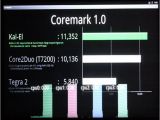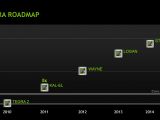During our visit at this year's Mobile World Congress, we've had the chance of getting a few moments out of the busy schedule of Mr. Michael Rayfield, the General Manager of NVIDIA's Tegra-oriented Mobile Business Unit.
Since the interview was carried out just after the official unveiling of the Kal-El quad-core Tegra platform, we've asked Mr. Rayfield a few questions on this matter, which we hope will provide you some insight on what we should expect from the company in the near future. Softpedia: We've seen plenty of new Internet tablets arrive on the market over the past few months, many of which are powered by the NVIDIA Tegra platform.
So, if you were to recommend customers a certain tablet, what would be some of the reasons why you'd advise them to get a model featuring Tegra 2? Michael Rayfield, NVIDIA: OK, so these tablets, they've gotten bigger, they're maybe 9 or 10 inches wide, which means that they've basically become computers. So, they've go beautiful user interfaces, they can do high definition video, they can certainly surf the web.
And since Tegra was designed to be a computer on a chip, it's got flash acceleration for the web, it's got the capability to play 1080p video, it's got the ability to do 3D user interfaces, and it's also got the ability to do great gaming.
In fact, many people who do get these devices want them to do gaming, casual gaming, but also some really elaborate gaming, with titles that run very smoothly.
And that's because Tegra allows that, it's the only processor that allows you to run high-end games on tablets.
Then, we have the same capabilities on devices with smaller displays, like phones (we actually call them “super-phones”), because they can actually do something absolutely amazing.
For example, you have a phone, you plug into a TV via HDMI and you can play 1080p videos or movies stored on your phone right on the TV screen.
And you can also play games, multi-player games...all of that is enabled by Tegra. Softpedia: It's by now a known fact that Tegra is also being implemented in car infotainment systems, coming from Audi, BMW, etc. Could you offer us some insights on what we should expect on the future in this area, and especially what car brands might adopt it? Michael Rayfield, NVIDIA: So yes, Tegra is being adopted by a lot of the automotive companies, by most of the Volkswagen group, and, as you've mentioned, BMW. Also, in the United States, there's an electric car company called Tesla that makes very nice, very beautiful cars, and actually have the whole center console turned into a 17-inch display powered by Tegra, where you can have your entire dashboard, and infotainment and safety systems. Cars now are getting pretty complex, they have lots of cameras for safety, you've got camera streams all around, so that you'll be able to see what's behind you, the system will show multiple movies to the backset area, to the children, for example.
The system will also provide navigation and safety features, taking all of these inputs from outside and conveying them to the customer in a very concise manner, maybe keeping them from falling asleep or going out of the road, or help them see the deer jumping in front of the car... So, there are lots of safety and lots of infotainment capabilities enabled by Tegra. And another reason why Tegra can do that, in terms of multimedia, is that it's really low-power, because, even if you think that a car's got a lot of electricity available, in reality, the lower the power consumption is, the higher the mileage is. Softpedia: And that's probably even more important in the case of electric cars, isn't it? Michael Rayfield, NVIDIA: Yes, that's true, it's even more important. But with a Tegra processor in your car, you'll sure to make it home. Softpedia: We've talked about smartphones, tablets, cars, but do you plan for the Tegra platform to go even beyond that? Michael Rayfield, NVIDIA: Yes, in fact, we've announced the next-generation Tegra platform, called Project Kal-el. The Tegra 2 is dual-core, and the new thing we've announced is actually quad-core and it's five times the performance of the current Tegra 2. We've also announced a roadmap that shows that every year we'll dramatically increase performance, getting in the end a nearly 100 times higher performance than the Tegra 2, while also being low-power too. And that's going to allow people to do even more things with their mobile devices, practically allowing these things to be integrated in fundamentally anything you want to become a computer, as they allow for great processing capabilities, numerous interfaces, they allow for sort of intuitive computing action. .. We're very excited about it, and this will be shipping in tablets in August. So, while Tegra 2 is just starting to launch, in less than one year from the launch of the first devices with Tegra 2, there will be devices with the next-generation launching as well. Softpedia: And when do you expect the tablets with Kal-el to be available on the market? Michael Rayfield, NVIDIA: Since the tablets will show up in August, you'll probably be able to buy one for Christmas, and that would make a great gift for this year's Christmas. Softpedia: NVIDIA's Tegra has quite some serious competition in the mobile platform's market, quite a lot of manufacturers coming up with specific solutions for this segment. So, why do you believe Tegra is superior, what's its edge over competitors like Qualcomm, Samsung, etc.? Michael Rayfield, NVIDIA: Well, as you've highlighted, there are a bunch of great people in this business, a bunch of good suppliers, but I think that we look at the business differently from most of them, we're looking from a computing-based angle. We're a computer company, we've been so for a long time, and so we bring the energies, and graphics, the video, decode capability and overall system power for viewing multimedia, and the ability to pull it all together, whether it's content, beautiful designs, etc. So, I think that the fundamental difference is how we look at the business and therefore how we architect our products. Qualcomm's a telecommunications company and we're not, we're a computer company, we still have to be about computers. Softpedia: Since you're talking about NVIDIA being a computing company, should we expect, at some point in the future, a 3D Vision – like experience of the Kal-el platform or its successors? Michael Rayfield, NVIDIA: Absolutely. We put in a new graphics processing unit, with 12 cores, we put 3D stereo, because, as you probably know, we've been doing 3D in PCs for quite a long time now, and we believe that, towards of this year, the rest of the eco-system will come together in terms of panels, content, things like that, and that's why we'll see 3D systems built on Tegra this year as well. Softpedia: But what kind of systems are we talking about? Smaller ones at first? Michael Rayfield, NVIDIA: Yes, I think initially there will be super-phones with 4 inches, 4 and a half inches, and ultimately, we'll go to tablets, with 10 inches. Softpedia: So, what are your expectations for Tegra in the 3 to 5 years interval? Michael Rayfield, NVIDIA: We've actually show a roadmap, revealing that, by 2014, we'll be approaching 100 times more computational capability than the Tegra 2, and the Tegra 2 is already very powerful, it's the most powerful SoC in the industry, and you can see that in all the tablets and the super-phones out there. So, we see this looking a lot like the PC business did, initially. It's all about velocity, we think that the change will be rapid enough that there will be a new generation each year, and that's a pace we really feel comfortable with. In the end, the consumer will ultimate ask for more, since they'll be offered new technologies, new products every year. Softpedia: And one more thing. From the roadmap you've shown, the future Tegras will be powerful enough to even drive small, entry-level notebooks. Any plans in that direction, and where to they fit in with project Denver? Michael Rayfield, NVIDIA: So yeah, that's out thought. We've already announced project Denver back at CES because we believed that ARM has the right instruction set and architecture for going forward, and we believe that, by combining a high-performance version of that with our high-performance GPU, we'll be able to create systems ranging from netbook computers to supercomputers. So, we'll have the Tegra for the more entry-level devices, and we'll have project Denver for the high-end devices, all the way to supercomputers. We're excited about that, and as time goes by, we really hope that we'll start seeing some of these devices show up.

 14 DAY TRIAL //
14 DAY TRIAL // 

